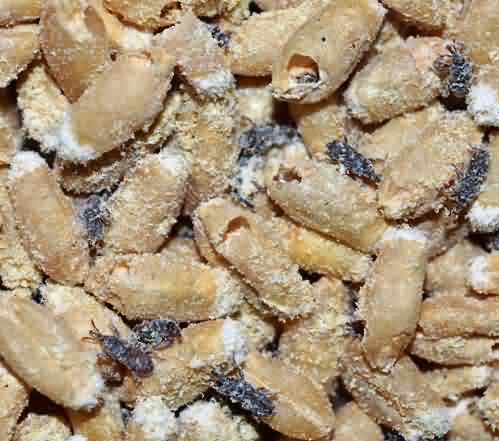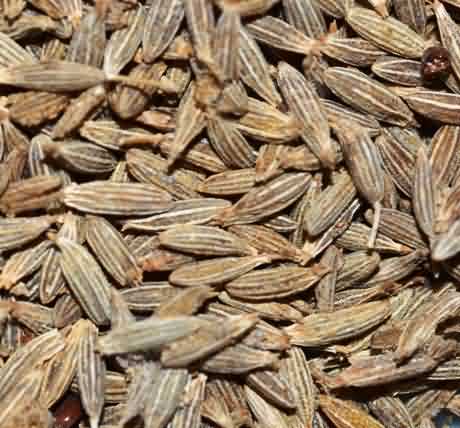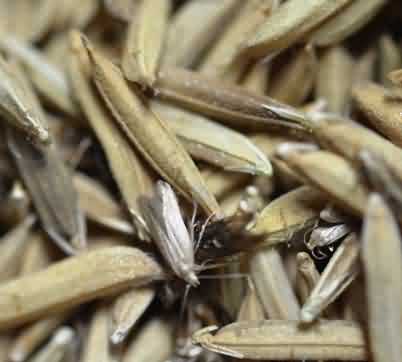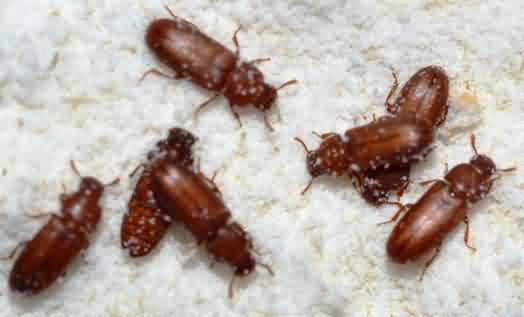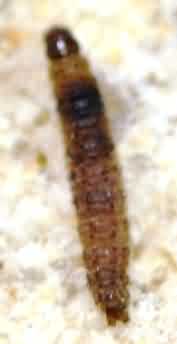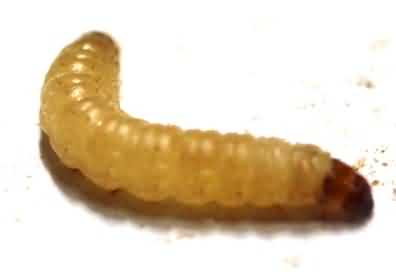संग्रहित अनाज के कीट-पतंग तथा उनका प्रबंधन
Global loss in stored products, caused by insects, have been estimated to be between five and ten percent. In the tropics it may reach upto 30%. Insects not only cause direct loss through consumption of kernels but also indirect losses which includes accumulation of frass, exuviae, webbing and insect cadavers. High levels of this insect detritus may result in grain that is unfit for human consumption. Storage insect pests are categorized into two types viz.,
1. Primary storage pests
Primary storage pests are those capable of penetrating and infesting intact kernels of grain, and have immature stages that can readily develop within a kernel of grain.
|
Insect |
Family : order |
Damaging stage |
Damage symptom |
Images |
|
Rice weevil Sitophilus oryzae |
Curculionidae: Coloeoptera |
Grubs and adults |
Grubs feed inside, grains are hollowed out and in some cases the kernels are reduced to powder. Adults make irregular holes on the grains. |
Adult weevil |
|
Khapra beetle Trogoderma granarium |
Dermestidae: Coleoptera
|
Grubs |
Grubs mainly attacks the grains of wheat, maize, sorghum, pulses and oil seeds. Grubs remain on the top few layers of the bulk grains |
|
|
Pulse beetles Callosobruchus chinensis C. maculatus C. analis |
Bruchidae: Coleoptera |
Grubs |
Individual eggs are laid on pulses by adult beetle and the emerging grubs feed on the inner contents and pupates inside the grain |
|
|
Cigarette beetle Lasioderma serricorne |
Anobiidae: Coleoptera |
Grubs and adults |
Grubs and adults feed on stored tobacco, turmeric, chillies and ginger |
|
|
Angoumois Grain Moth Sitotroga cerealella
|
Gelechidae Lepidoptera |
Larvae |
Infestation confined only to upper 30 cms depth. Larvae makes hole and feeds the internal content. Pupation takes place inside the grain. Adult emerge out by circular 'flap ' or 'trap door '. |
Adult |
2. Secondary storage pests
Secondary storage pests cannot infest sound grain but feed on broken kernels, debris and grain damaged by primary insect pests. In general, the immature stages of these species are found external to the grain.
|
Insect |
Family : Order |
Damaging stage |
Damage symptom |
Images |
|
Rust Red flour beetle Tribolium castaneum |
Tenebrionidae: Coloeoptera |
Grubs and adults |
Grubs and adults feed on milled products but can also attack broken grains |
Adult |
|
Almond moth Ephestia cautella |
Phyctidae: Lepidoptera |
Larvae |
The larvae webs the grains and feed on germ portion leaving the rest of the kernel undamaged |
Larvae |
|
Rice moth Corcyra cephalonica |
Galleridae: Lepidoptera |
Larvae |
Larvae pollutes food grains with frass, moults and dense webbing |
Larvae |
|
Indian meal moth Plodia interpunctella |
Phyctidae: Lepidoptera |
Larvae |
Insect prefers to feed on the germ portion, hence the grains lose viability.Larvae contaminates the grain with excrement, webbings, dead individuals and Exuviae.
|
|
|
Saw toothed grain beetle Oryzaephilus surinamensis |
Cucjidae: Coleoptera |
Grubs and adults |
Grubs and adults feeds grains which are already damaged by primary pests |
|
|
Flat grain beetle Cryptolestes minutus |
Cucjidae: Coleoptera |
Grubs and adults |
Grubs attacks only broken grains |
|
|
Long headed flour beetle Latheticus oryzae |
Tenebrionidae: Coleoptera |
Grubs and adults |
Grubs attacks only broken grains |
The integrated pest management (IPM) approach for stored grain includes:
1. Sanitation:
- It should be maintained at both field and storage godowns.
- Undergo clean harvest.
- Both harvesting and threshing machines need to be thoroughly cleaned prior to use.
- Never store a new crop along with the old grain.
- Cracks and crevices should be properly sealed
- Remove spilled grain outside the storage structure.
- Rat burrows to be closed with a mixture of broken glass pieces and plastered with cement.
- For additional protection, the inside and outside surfaces, foundations and floor of a storage facility should be treated with a residual insecticide, four to six weeks prior to harvest.
- The grain is monitored every 2-3 weeks during throughout storage period
- careful monitoring should be done on the following parameters:Aeration is used to dry and cool the newly stored grain there by prevent the development of hotspots. It is also used to prevent moisture migration when ambient temperatures drop below that of the grain temperature.
- Grain quality
- Grain temperature
- Insects and insect density
- Hot spots
- Mould growth
- Any “off odor”
2. Frequent monitoring:
Pest monitoring is an important component in the post-harvest IPM practice for stored grain
3. Aeration
Proper aeration in stored grain controls humidity and reduce the possibility of pest infestation
4. Pesticide treatments
Infestation develops due to hidden or cross infestation, which could be effectively managed by using the following insecticides and fumigants.
Grain protectants: it is not advisable to mix the chemical dust along with food grains as it is meant for human consumption. However, they can be mixed with the grains meant for seed purposes only. Pyrethrum dust, Spinosad dust etc. are normally used as seed protectants.
Fumigants: Properly conducted fumigation will stop insect infestation and effectively reduce the pest populations.
Aluminum phosphide: This is a most widely used fumigant in India and available in the market under trade name Celphos of 3 gm tablets. The phosphide pellets or tablets release phosphine gas as they are exposed to moisture in the air. The recommended dose is 3tablets/tonne of grains.
Reference:
TnauAgritech Poratal - http://agritech.tnau.ac.in/index.html
David¸B.V and Ramamurthy, V.V. 2012. Elements of economic entomology. Book Chapter: Insect pests of Stored grain Products.
Authors:
Guru Pirasanna Pandi G., Soumia P.S. and Thava Prakasa Pandian R.
Ph D Scholars, Indian Agricultural Research Institute, New Delhi.
Email:

